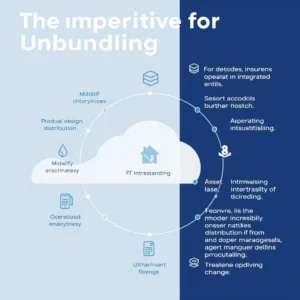Unbundling Value: How Leading Insurers Identify Competitive Advantage

The insurance industry stands at a strategic inflection point, where traditional business models are being dismantled and reimagined. Facing persistent profitability challenges, technological disruption, and evolving market dynamics, leading insurers are adopting a radical approach: unbundling their value chains to focus on core strengths. This strategic shift is transforming how insurers create value, compete, and position themselves for the future.
The Imperative for Unbundling
For decades, insurers operated as integrated entities, controlling every aspect of their value chain—from product design and distribution to asset management and claims processing. However, this model is increasingly unsustainable. Several converging forces are driving change:
-
Erosion of Competitive Moats: Private capital-backed platforms now dominate segments like legacy policy acquisitions and niche product categories, outperforming traditional insurers in efficiency and innovation.
-
Persistent Profitability Pressures: Sensitivity to interest rates, regulatory costs, and opaque risk exposures continue to compress margins.
-
Technological Stagnation: Despite heavy investments, many insurers struggle to modernize operations, with net expenses remaining stubbornly high.
-
Shifting Distribution Dynamics: Independent channels and digital platforms are capturing market share, reducing insurers’ control over customer relationships.
These challenges demand a fundamental reassessment of where insurers can realistically build competitive advantage.
The Four Pillars of the Insurance Value Chain
Unbundling requires dissecting the insurance value chain into its core components and identifying where an insurer can truly excel:
-
New-Product Development:
-
Competitive advantage hinges on customer-centric design, dynamic pricing, and risk assessment capabilities.
-
Leading insurers focus on specific product categories aligned with their risk appetite and capital efficiency, exiting non-core segments.
-
Partnerships (e.g., white-labeling, reinsurance) fill gaps where internal capabilities fall short.
-
-
Distribution:
-
Digital-first channels and third-party platforms are reshaping access to customers.
-
Winners leverage omnichannel strategies, embedded insurance models, and data-driven personalization.
-
-
Asset Management:
-
A widening gap separates top- and bottom-quartile performers in investment returns.
-
Distinctiveness requires sophisticated asset-liability management and dynamic allocation strategies.
-
-
Operations and Technology:
-
Legacy systems and inefficient processes remain Achilles’ heels.
-
Future-focused insurers prioritize cloud migration, automation, and API-driven ecosystems over monolithic overhauls.
-
Three Archetypes for the Future
As insurers unbundle, three dominant models are emerging:
-
Product Origination Specialists:
-
Excel in designing innovative, customer-centric products (e.g., parametric insurance, hybrid life/investment solutions).
-
Often partner with balance sheet specialists for risk underwriting and capital management.
-
-
Balance Sheet Specialists:
-
Focus on capital efficiency, liability management, and investment performance.
-
Typically acquire blocks of business from originators, optimizing long-term returns.
-
-
Integrated Insurers:
-
The rarest model, reserved for insurers with scale and capabilities across the chain.
-
Maintain control over product design, distribution, and asset management but outsource non-core operations.
-
The Path to Competitive Advantage
Transitioning to an unbundled model requires decisive action:
-
Ruthless Self-Assessment:
-
Audit each business unit to identify where distinctive capabilities exist (e.g., underwriting excellence in commercial lines, digital distribution in auto insurance).
-
Exit segments where competitive differentiation is unattainable.
-
-
Strategic Partnerships:
-
Forge alliances to fill capability gaps. A product specialist might partner with a tech firm for claims automation, while a balance sheet player collaborates with insurtechs for customer acquisition.
-
-
Talent and Technology Alignment:
-
Redirect investments toward capabilities that reinforce core strengths (e.g., AI-driven pricing for originators, ESG analytics for balance sheet managers).
-
Reskill teams to focus on high-value activities like data science and ecosystem development.
-
-
Cultural Shift:
-
Move from “ownership” of the value chain to “orchestration,” embracing fluid competitor-collaborator relationships.
-
Conclusion: The New Competitive Landscape
Unbundling is not merely a cost-cutting exercise—it’s a strategic realignment that allows insurers to thrive in a fragmented, dynamic market. The winners will be those who shed the illusion of universal competence and instead double down on select areas of excellence. As boundaries between insurers, tech firms, and asset managers blur, the future belongs to organizations that master focused differentiation while leveraging collaborative ecosystems. For insurers willing to make bold choices, unbundling offers a path from survival to sustained leadership.




